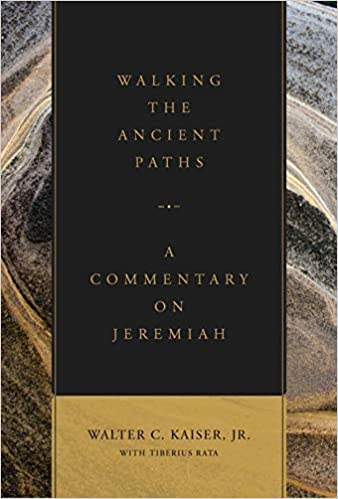A Book Review from Books At a Glance
By Riane K. McConnell
Walking the Ancient Paths serves as an adequate sequential overview and portrayal of the thematic overtures found in the book of Jeremiah. It is not a part of a commentary series but rather an independent volume. Walter C. Kaiser, Jr. is Colman M. Mockler Distinguished Professor Emeritus of Old Testament and former President of Gordon-Conwell Theological Seminary (South Hamilton, Massachusetts) and Tiberius Rata is associate dean of the school of Ministry Studies and professor of Old Testament at Grace Seminary (Winona Lake, Indiana).
While there have been many commentaries written on the book of Jeremiah, Kaiser and Rata take a new approach that focuses on the land, landmarks, and ancient culture referenced in the book of Jeremiah. The commentary is organized in eight sections, based on three overarching sections adapted from T. Laetsch: God’s protection, the complete destruction of Judah, and God’s promise of deliverance (p. 17). Kaiser and Rata incorporate discussions of geographical landmarks/landscapes, intertextual comparisons, and interact with a diversity of scholars. These building blocks result in an overarching theology of restoration to the people and land through Yahweh.
The authors’ use the Hebrew text preserved in the Masoretic tradition (MT), but refer to the LXX reading throughout the footnotes. In the introduction, Kaiser and Rata discuss the limitations and differences of the LXX in comparison to the MT and ultimately assert, “Most scholars still depend on the Hebrew text rather than the LXX as their basic text” (p. 12).
As mentioned above, the commentary is divided into eight chapters, each containing four to twelve smaller periscopes. By far the longest chapter is entitled ‘The Personal Struggles of the Prophet’ covering chapters 2-25 in Jeremiah (p. 43-305). In this chapter, Kaiser and Rata highlight key theological topics as referred to by Jeremiah (i.e., marriage and divorce, circumcision, Israel’s insolence and Judah’s following, and Jeremiah’s anguish in response to Yahweh’s message). Beyond literary and syntactical analysis, Kaiser and Rata give insight to special geographical references, landmarks, valleys, towns, and mentions of creation.
Before Kaiser and Rata move to Jeremiah’s discussion of the destruction of Judah, a chapter is dedicated to the future “Restoration of Israel and Judah to the Land” contained in Jeremiah 30-33. Using the six strophe pattern developed by Charles Briggs, they discuss the six features of the new covenant: Jacob’s trouble, The Healing of Israel’s Incurable Wound, God’s Firstborn Restored to the Land, Rachel Weeping for Her Children, The New Covenant, and The Inviolable Covenant Given to Israel. Ultimately, they tie Israel’s reconciliation to Yahweh to Yahweh’s restoration of the land. Kaiser and Rata provide an intertextual comparison between the “new covenant” outlined in Jeremiah 31 and previous covenants Yahweh established with his people: Noah in Gen 9 and David in 1 Kings 2.
The commentary is insightful and relevant. For example, in describing Jeremiah’s call for faithfulness among the last kings of Judah, the authors use American government officials and leaders as an example. This comparison is made to emphasize the arrogance portrayed by Judean kings in comparison to that of the American government and leaders. They end in stating, “Only to see so many in recent years speak or act as if God is now dead and they are the proper survivors! But God is still watching!” (p. 427).
The Book of Jeremiah concludes with the fall of Jerusalem in chapters 37-45. As Babylon takes Jerusalem and its residents captive, the chapter concludes with Yahweh’s judgment and mercy. Kaiser and Rata acknowledge that Yahweh’s judgment and mercy is not to be “misunderstood” in these final chapters. Kaiser and Rata conclude that Yahweh becomes the focal point in the final curses and blessings. As the book concludes, it is through Yahweh that restoration is given. This restoration does not focus solely on the people of Israel but an integrated restoration of the land, people, and Yahweh. Kaiser and Rata end by integrating prophetic texts from Isaiah and Ezekiel to focus on the future restoration discussed in chapters 30-33.
The authors present the commentary of Jeremiah in eight dynamic sections. Each section systematically interprets each verse in a chronological fashion. While each verse is adequately expounded upon, there is little room for intertextual explanations and emerging theological themes and concepts to make their way onto the page. Kaiser and Rata present a syntactic exposition of Jeremiah; however, they present little in way of theology and intertextuality due to their narrow focus.
To conclude, Kaiser and Rata provide a thorough integration and explanation of the MT, LXX, intertextual comparisons, and the role of geography found in Jeremiah. Not only does geography play a crucial role in understanding the Hebrew text of Jeremiah but also Yahweh’s plans for restoration. Furthermore, the authors give attention to geographical references and intertextual comparisons (seen in Jeremiah) demonstrate deeper theological themes in the life of Jeremiah and the restoration of Yahweh’s people and land.
Riane K. McConnell is Master of Arts student in Old Testament and Semitic Languages at Trinity Evangelical Divinity School (Deerfield, Illinois).
Buy the books

WALKING THE ANCIENT PATHS: A COMMENTARY ON JEREMIAH, by Walter C. Kaiser Jr. and Tiberius Rata